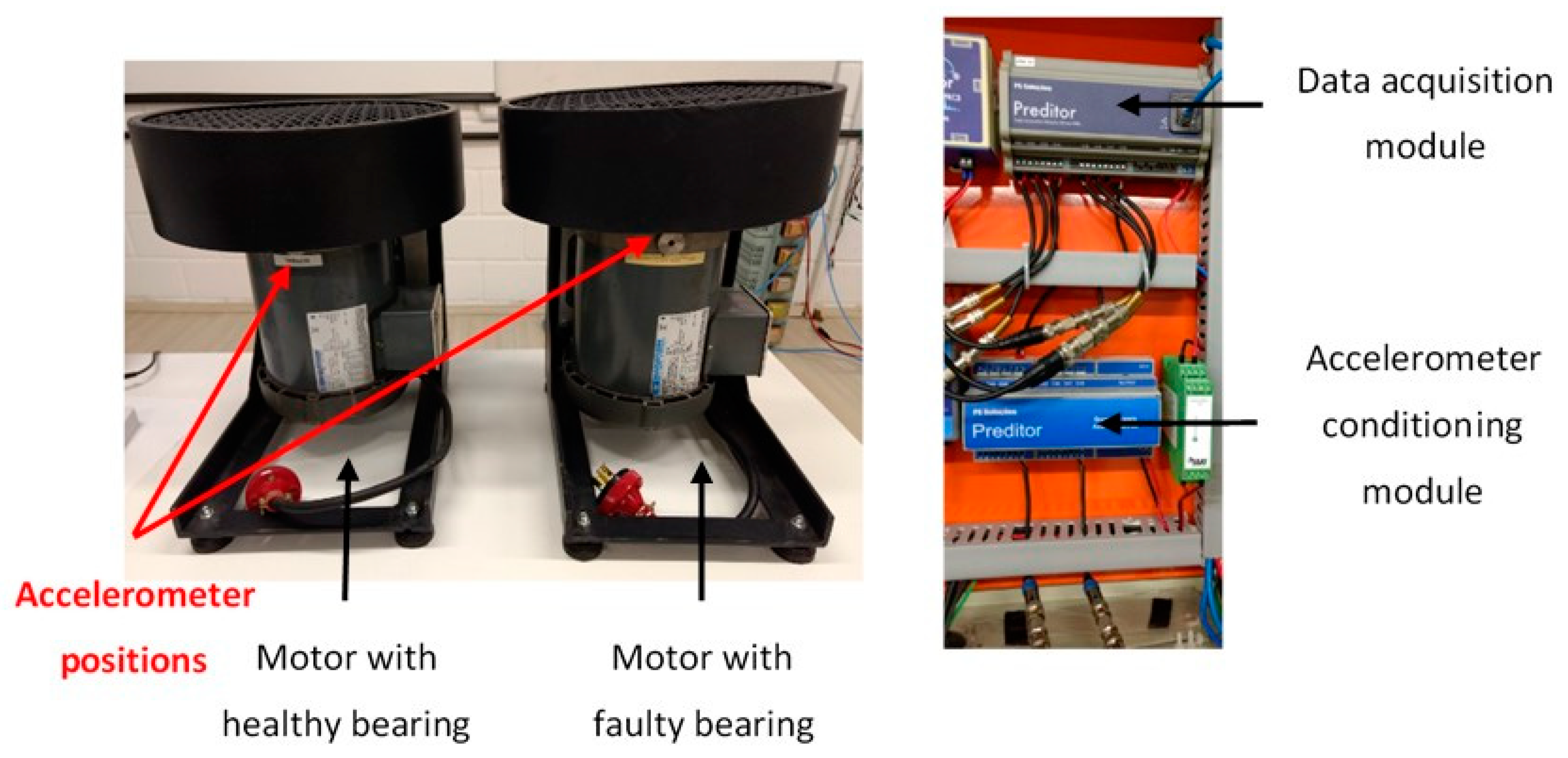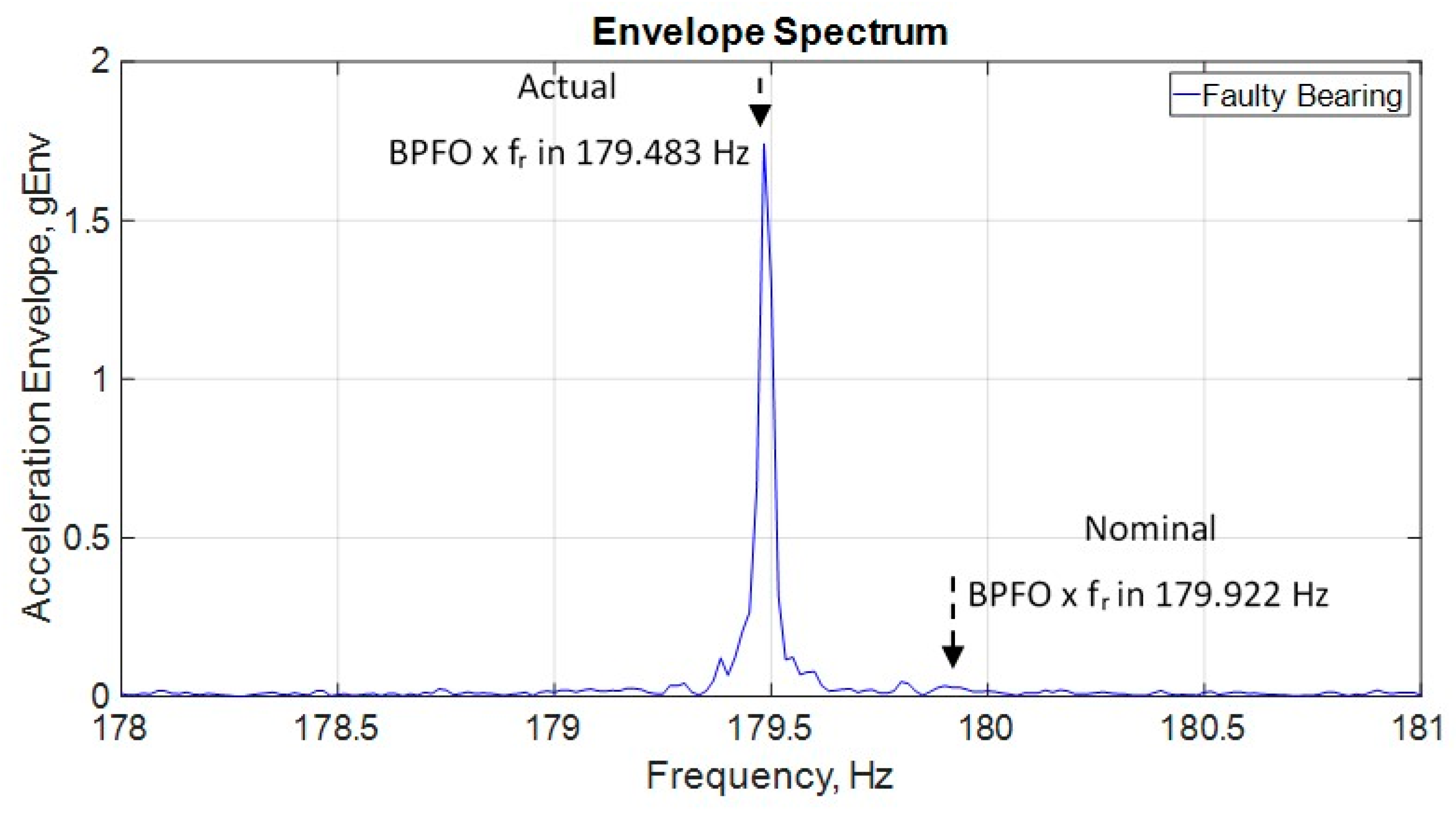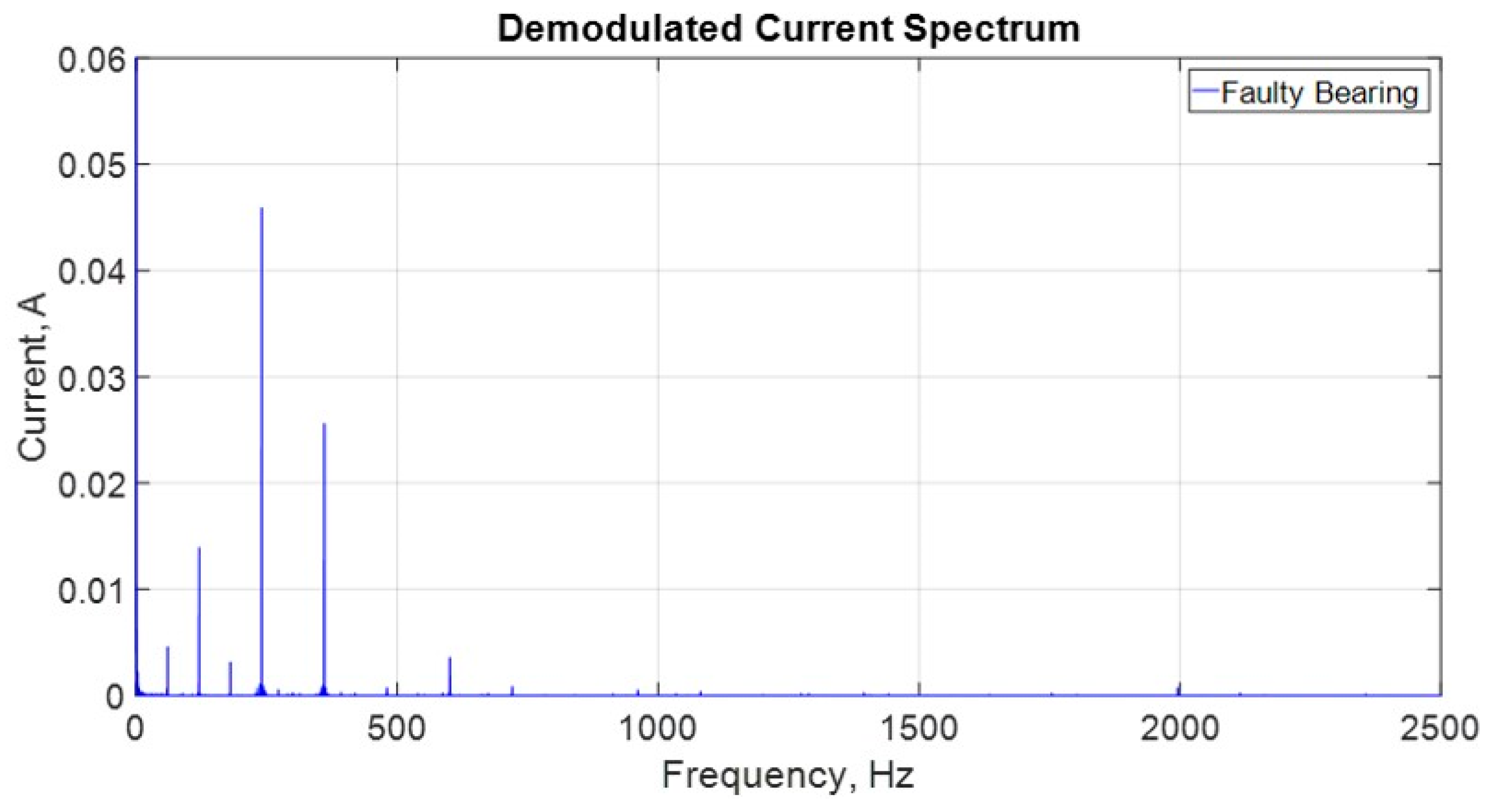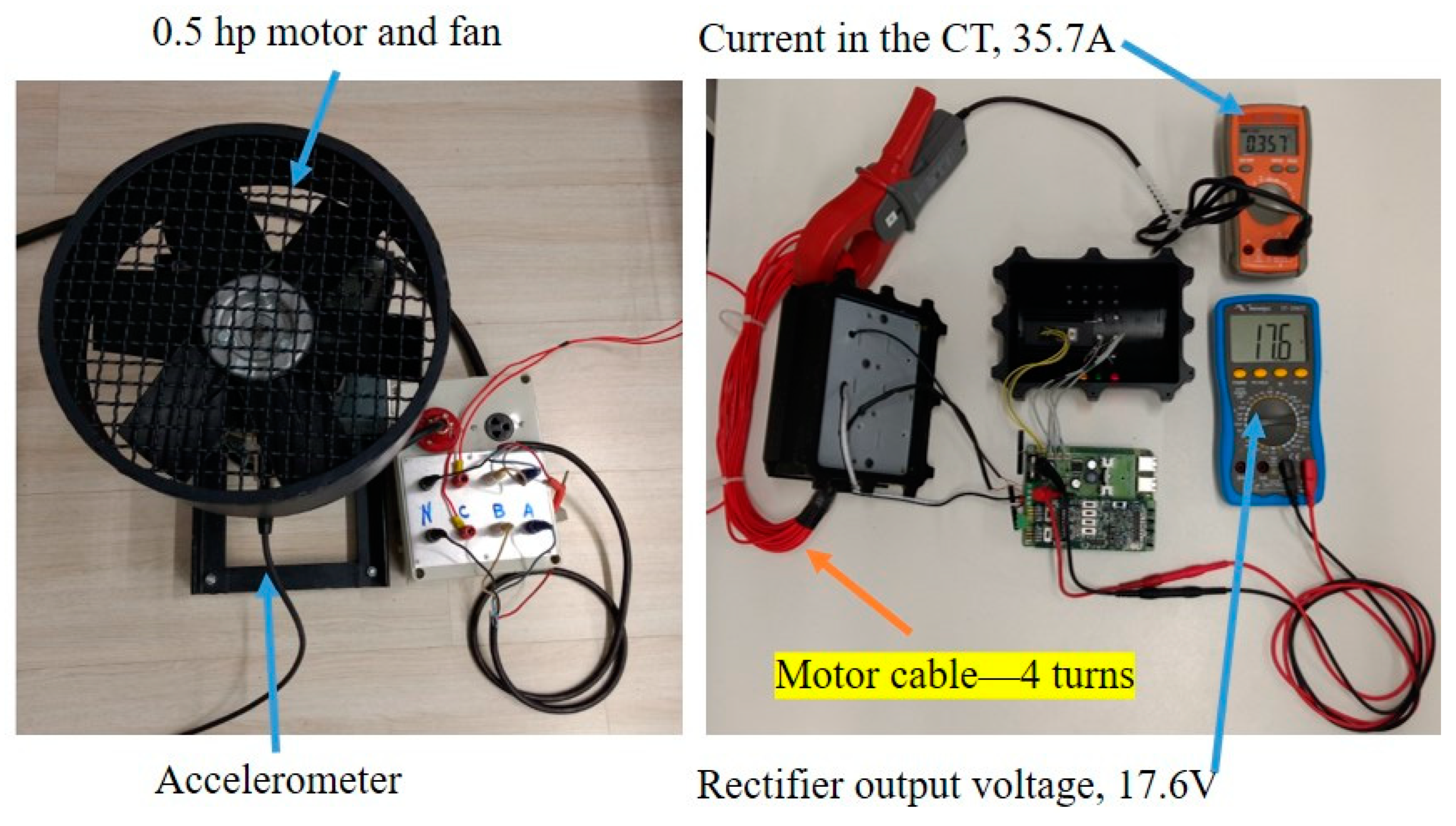Evaluation of Current Signature in Bearing Defects by Envelope Analysis of the Vibration in Induction Motors
Abstract
:1. Introduction
- BPFO—Ball Pass Frequency in the Outer Race;
- BPFI—Ball Pass Frequency in the Inner Race;
- BSF—Ball Spin Frequency;
- FTF—Frame Train Frequency.
2. Detection of Localized Faults in Roller Bearings
3. Bearing Fault Detection by the Current Signature Analysis
4. Proposition Demonstration and Experimental Results
4.1. Vibration Analysis
4.2. Current Analysis
5. Proposition of a Self-Supplied Wireless Current Transducer—SSWCT
6. Conclusions
Author Contributions
Funding
Acknowledgments
Conflicts of Interest
Nomenclature
| Abbreviations | |
| AC | Alternate Current |
| ADC | Analog-to-Digital Converter |
| BPFO | Ball Pass Frequency – Outer Race |
| CT | Current Transformer |
| DC | Direct Current |
| MCSA | Motor Current Signature Analysis |
| SBC | Single Board Computer |
| SSWCT | Self-Supplied Wireless Current Transducer |
| Parameters | |
| d | Ball diameter |
| D | Pitch diameter |
| fbng | Vibration frequency |
| fc | Frequency of lateral components in the fundamental component |
| fe | Supply frequency |
| f1 | Mains frequency |
| fr | Shaft rotating frequency |
| s | Rotor slip |
| m | Positive integer referring to the vibration component harmonics |
| Nb | Number of balls |
| α | Bearing contact angle |
Appendix A. Rotor Frequency Measurement and BPFO Accuracy Consideration

References
- Zhang, P.; Du, Y.; Habetler, T.G.; Lu, B. A survey of condition monitoring and protection methods for medium-voltage induction motors. IEEE Trans. Ind. Appl. 2011, 47, 34–36. [Google Scholar] [CrossRef]
- Immovilli, F.; Bianchini, C.; Cocconcelli, M.; Bellini, A.; Rubini, R. Bearing fault model for induction motor with externally induced vibration. IEEE Trans. Ind. Electron. 2013, 60, 3408–3418. [Google Scholar] [CrossRef]
- Prieto, M.D.; Cirrincione, G.; Espinosa, A.G.; Ortega, J.; Henao, H. Bearing fault detection by a novel condition-monitoring scheme based on statistical-time features and neural networks. IEEE Trans. Ind. Electron. 2013, 60, 3398–3407. [Google Scholar] [CrossRef]
- Salomon, C.P.; Santana, W.C.; Lambert-Torres, G.; Borges da Silva, L.E.; Bonaldi, E.L.; de Oliveira, L.E.L.; Borges da Silva, J.G.; Pellicel, A.; Figueiredo, G.C.; Lopes, M.A.A. Discrimination of Synchronous Machines Rotor Faults in Electrical Signature Analysis based on Symmetrical Components. IEEE Trans. Ind. Appl. 2017, 53, 3146–3155. [Google Scholar] [CrossRef]
- Fu, L.; Zhu, T.; Zhu, K.; Yang, Y. Condition Monitoring for the Roller Bearings of Wind Turbines under Variable Working Conditions Based on the Fisher Score and Permutation Entropy. Energies 2019, 12, 3085. [Google Scholar] [CrossRef]
- Li, X.; Elasha, F.; Shanbr, S.; Mba, D. Remaining Useful Life Prediction of Rolling Element Bearings Using Supervised Machine Learning. Energies 2019, 12, 2705. [Google Scholar] [CrossRef]
- Blodt, M.; Granjon, P.; Raison, B.; Rostaing, G. Models for bearing damage detection in induction motors using stator current monitoring. IEEE Trans. Ind. Electron. 2008, 55, 1813–1822. [Google Scholar] [CrossRef]
- Bonaldi, E.L.; de Oliveira, L.E.L.; Borges da Silva, J.G.; Lambert-Torres, G.; Borges da Silva, L.E. Predictive maintenance by electrical signature analysis to induction motors. In Induction Motors—Modelling and Control; Araujo, R., Ed.; InTech: Rijeka, Croatia, 2012; pp. 487–520. [Google Scholar] [CrossRef]
- Bonaldi, E.L.; de Oliveira, L.E.L.; Borges da Silva, J.G.; Lambert-Torres, G.; Borges da Silva, L.E. Detecting load failures using the induction motor as a transducer. In Proceedings of the International Conference on Control, Automation, Robotics and Vision, Hanoi, Vietnam, 17–20 December 2008; pp. 196–199. [Google Scholar] [CrossRef]
- Immovilli, F.; Bellini, A.; Rubini, R.; Tassoni, C. Diagnosis of bearing faults in induction machines by vibration or current signals: A critical comparison. IEEE Trans. Ind. Appl. 2010, 46, 1350–1359. [Google Scholar] [CrossRef]
- Gong, X.; Qiao, W. Bearing fault diagnosis for direct-drive wind turbines via current-demodulated signals. IEEE Trans. Ind. Electron. 2013, 60, 3419–3428. [Google Scholar] [CrossRef]
- Chang, H.-C.; Jheng, Y.-M.; Kuo, C.-C.; Hsueh, Y.-M. Induction Motors Condition Monitoring System with Fault Diagnosis Using a Hybrid Approach. Energies 2019, 12, 1471. [Google Scholar] [CrossRef]
- Tavner, P.; Ran, L.; Penman, J.; Sedding, H. Condition Monitoring of Rotating Electrical Machines; The Institution of Engineering and Technology: London, UK, 2008. [Google Scholar]
- Elbouchikhi, E.; Choqueuse, V.; Amirat, Y.; Benbouzid, M.E.H.; Turri, S. An efficient Hilbert-Huang transform-based bearing faults detection in induction machines. IEEE Trans. Energy Conv. 2017, 32, 401–413. [Google Scholar] [CrossRef]
- Cusido, J.; Romeral, L.; Garcia, A.; Rosero, J.A.; Ortega, J.A. Fault detection in induction machines by using continuous and discrete wavelet decomposition. In Proceedings of the 2007 European Conference on Power Electronics and Applications, Aalborg, Denmark, 2–5 September 2007. [Google Scholar] [CrossRef]
- Randall, R.B. Vibration-Based Condition Monitoring; John Wiley & Sons Ltd.: New York, NY, USA, 2011. [Google Scholar]
- Salomon, C.P.; Santana, W.C.; Bonaldi, E.L.; de Oliveira, L.E.L.; Borges da Silva, L.E.; Borges da Silva, J.G.; Lambert-Torres, G.; Pellicel, A.; Lopes, M.A.A.; Figueiredo, G.C. A study of electrical signature analysis for two-pole synchronous generators. In Proceedings of the 2017 IEEE International Instrumentation and Measurement Technology Conference (I2MTC), Turin, Italy, 22–25 May 2017; pp. 1–6. [Google Scholar] [CrossRef]
- He, D.; Li, R.; Zhu, J. Plastic bearing fault diagnosis based on a two-step data mining approach. IEEE Trans. Ind. Electron. 2013, 60, 3429–3440. [Google Scholar] [CrossRef]
- Sui, W.; Zhang, D. Research on envelope analysis for bearings fault detection. In Proceedings of the International Conference on Computer Science & Education, Hefei, China, 24–27 August 2010; pp. 973–976. [Google Scholar] [CrossRef]
- IEEE Standard for Information Technology-Telecommunications and information exchange between systems Local and metropolitan area networks-Specific requirements Part 11: Wireless LAN Medium Access Control (MAC) and Physical Layer (PHY) Specifications Amendment 3: Enhancements for Very High Throughput to Support Chinese Millimeter Wave Frequency Bands (60 GHz and 45 GHz). In IEEE Std 802.11aj-2018 (Amendment to IEEE Std 802.11-2016 as amended by IEEE Std 802.11ai-2016 and IEEE Std 802.11ah-2016). 18 April 2018; 1–306. [CrossRef]
- Schoen, R.R.; Habetler, T.G.; Kamran, F.; Bartfield, R.G. Motor bearing damage detection using stator current monitoring. IEEE Trans. Ind. Appl. 1995, 31, 1274–1279. [Google Scholar] [CrossRef]
- Riley, C.M.; Lin, B.K.; Habetler, T.G.; Schoen, R.R. A method for sensorless on-line vibration monitoring of induction machines. IEEE Trans. Ind. Appl. 1988, 34, 1240–1245. [Google Scholar] [CrossRef]
- Bonnardot, F.; Randall, R.B.; Antoni, J.; Guillet, F. Enhanced unsupervised noise cancelation (E-SANC) using angular resampling—Application for planetary bearing fault diagnosis. In Proceedings of the 5th International Conference Acoustical and Vibratory Surveillance Methods and Diagnostic Techniques, Senlis, France, 11–13 October 2004; pp. 1–11. [Google Scholar]
- Salomon, C.P.; Ferreira, C.; Sant’Ana, W.C.; Lambert-Torres, G.; Borges da Silva, L.E.; Bonaldi, E.L.; de Oliveira, L.E.L.; Torres, B.S. A Study of Fault Diagnosis Based on Electrical Signature Analysis for Synchronous Generators Predictive Maintenance in Bulk Electric Systems. Energies 2019, 12, 1506. [Google Scholar] [CrossRef]















© 2019 by the authors. Licensee MDPI, Basel, Switzerland. This article is an open access article distributed under the terms and conditions of the Creative Commons Attribution (CC BY) license (http://creativecommons.org/licenses/by/4.0/).
Share and Cite
Areias, I.A.d.S.; Borges da Silva, L.E.; Bonaldi, E.L.; de Lacerda de Oliveira, L.E.; Lambert-Torres, G.; Bernardes, V.A. Evaluation of Current Signature in Bearing Defects by Envelope Analysis of the Vibration in Induction Motors. Energies 2019, 12, 4029. https://doi.org/10.3390/en12214029
Areias IAdS, Borges da Silva LE, Bonaldi EL, de Lacerda de Oliveira LE, Lambert-Torres G, Bernardes VA. Evaluation of Current Signature in Bearing Defects by Envelope Analysis of the Vibration in Induction Motors. Energies. 2019; 12(21):4029. https://doi.org/10.3390/en12214029
Chicago/Turabian StyleAreias, Isac Antônio dos Santos, Luiz Eduardo Borges da Silva, Erik Leandro Bonaldi, Levy Ely de Lacerda de Oliveira, Germano Lambert-Torres, and Vitor Almeida Bernardes. 2019. "Evaluation of Current Signature in Bearing Defects by Envelope Analysis of the Vibration in Induction Motors" Energies 12, no. 21: 4029. https://doi.org/10.3390/en12214029





